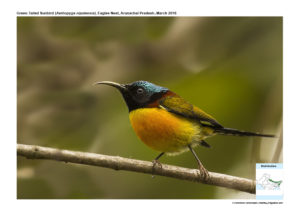Green-tailed Sunbird

Green-tailed Sunbird Aethopyga nipalensis
Etymology:
- Aethopyga : Greek word aithos – fire, burning heat; puge– rump
- Nipalensis: From Nepal
Distribution in India: Resident of Himalayas and North East of India.
Description: Size of male is 14–15 cm, wt. of 5·5–8 g; size of female 10 cm, wt. of 5·4–6·5 g. It hasa long, heavy-based curved bill. The male of nominate race has crown, nape, uppertail-coverts and graduated tail in metallic green to blue-green, tail is white-tipped visible from below and with elongated central feathers. The sides of neck and upper back are crimson-brown or maroon, upperwing and middle of back is olive-green, lower back is yellow, rump is bright yellow. The cheek is blackish glossed purple or violet, throat metallic green, underpartsare bright yellow, streaked scarlet on breast. The iris is dark brown or reddish-brown; bill and legs are black or dark brown, underside of toes are paler. The female is olive-green, greyer on head, slightly yellowish below; feathers of graduated tail except central pair are variably tipped white, sometimes almost no white tipping at all; bare parts are similar tothe male. The juvenile is similar to female, but has greener crown, is yellower below, has less graduated tail with less obvious pale tips. The young male is washed orange on breast, later developing green nape, maroon scapulars and elongated tail feathers.
Habitat: It is found in primary forests , submontane and montane forest, woodland, scrub-jungle, among rhododendrons, around flowering trees, in secondary growth, orchards and gardens. It is found from 300–3665 m.
Food habits: It eats small arthropods and nectar. It forages singly and in small, loose groups; often in canopy, but also at lower levels.
Breeding habits: They breed in Apr–Jun in India and Nepal, and in Thailand. The nest is an untidy oval purse, , entrance near top or half-way up, made from vegetable down and green moss, decorated with caterpillar frass and bits of bark, suspended above ground from end of twig. They lay a clutch of 2 or 3 eggs. Thenest is parasitized by Asian Emerald Cuckoo.